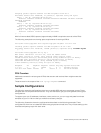Match a Clause with a Continue Clause
The continue feature can exist without a match clause.
Without a match clause, the continue clause executes and jumps to the specified route-map entry. With
a match clause and a continue clause, the match clause executes first and the continue clause next in a
specified route map entry. The continue clause launches only after a successful match. The behavior is:
• A successful match with a continue clause—the route map executes the set clauses and then goes to
the specified route map entry after execution of the continue clause.
• If the next route map entry contains a continue clause, the route map executes the continue clause if
a successful match occurs.
• If the next route map entry does not contain a continue clause, the route map evaluates normally. If a
match does not occur, the route map does not continue and falls-through to the next sequence
number, if one exists
Set a Clause with a Continue Clause
If the route-map entry contains sets with the continue clause, the set actions operation is performed first
followed by the continue clause jump to the specified route map entry.
• If a set actions operation occurs in the first route map entry and then the same set action occurs with
a different value in a subsequent route map entry, the last set of actions overrides the previous set of
actions with the same set command.
• If the set community additive and set as-path prepend commands are configured, the
communities and AS numbers are prepended.
Enabling MBGP Configurations
Multiprotocol BGP (MBGP) is an enhanced BGP that carries IP multicast routes. BGP carries two sets of
routes: one set for unicast routing and one set for multicast routing. The routes associated with multicast
routing are used by the protocol independent multicast (PIM) to build data distribution trees.
MBGP for IPv4 multicast is supported on the Z9500 switch.
In the Dell Networking OS, MBGP is implemented per RFC 1858. You can enable the MBGP feature per
router and/or per peer/peer-group.
The default is IPv4 Unicast routes.
When you configure a peer to support IPv4 multicast, the system takes the following actions:
• Send a capacity advertisement to the peer in the BGP Open message specifying IPv4 multicast as a
supported AFI/SAFI (Subsequent Address Family Identifier).
• If the corresponding capability is received in the peer’s Open message, BGP marks the peer as
supporting the AFI/SAFI.
• When exchanging updates with the peer, BGP sends and receives IPv4 multicast routes if the peer is
marked as supporting that AFI/SAFI.
• Exchange of IPv4 multicast route information occurs through the use of two new attributes called
MP_REACH_NLRI and MP_UNREACH_NLRI, for feasible and withdrawn routes, respectively.
• If the peer has not been activated in any AFI/SAFI, the peer remains in Idle state.
Most BGP IPv4 unicast commands are extended to support the IPv4 multicast RIB using extra options to
the command. For a detailed description of the MBGP commands, refer to the Dell Networking OS
Command Line Interface Reference Guide.
202
Border Gateway Protocol IPv4 (BGPv4)


















